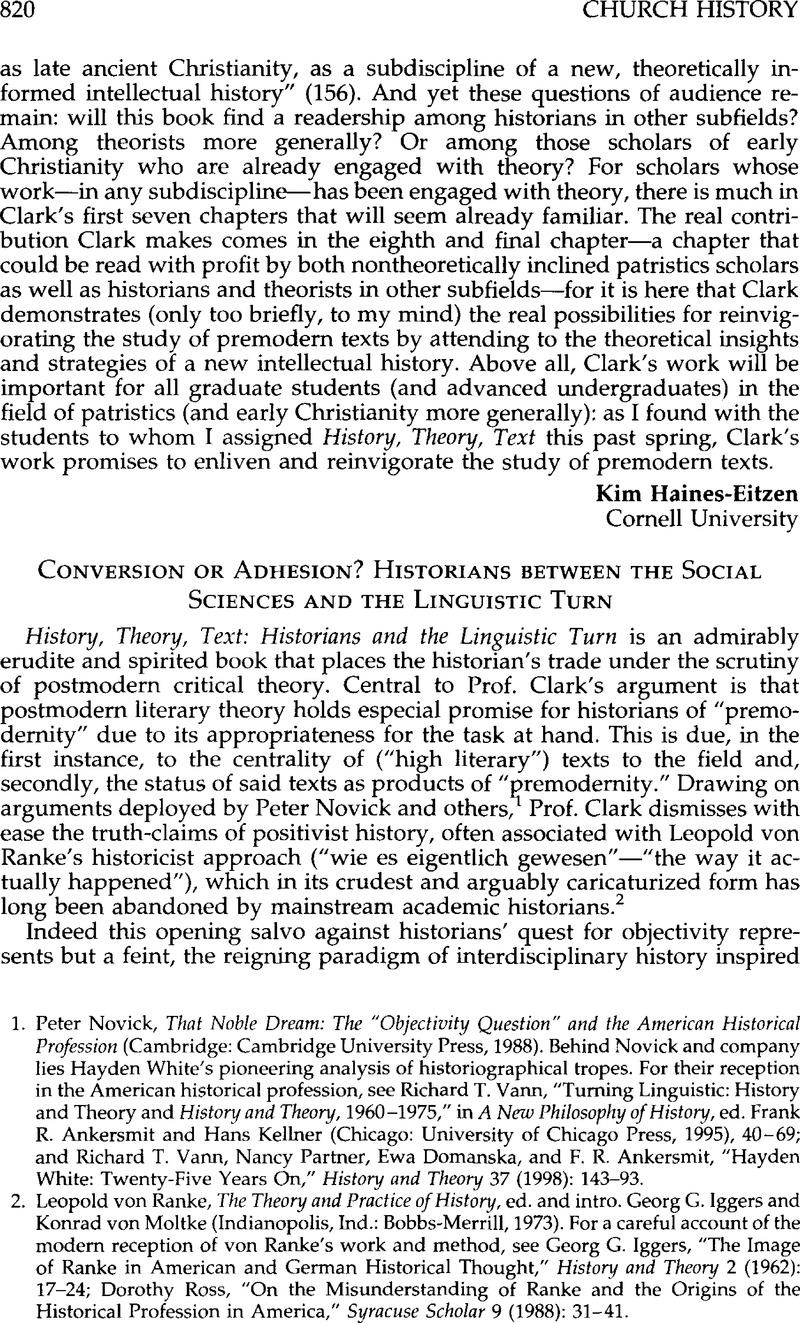No CrossRef data available.
Published online by Cambridge University Press: 28 July 2009

1. Peter, Novick, That Noble Dream: The “Objectivity Question” and the American Historical Profession (Cambridge: Cambridge University Press, 1988)Google Scholar. Behind Novick and company lies Hayden White's pioneering analysis of historiographical tropes. For their reception in the American historical profession, see Vann, Richard T., “Turning Linguistic: History and Theory and History and Theory, 1960–1975,” in A New Philosophy of History, ed. Ankersmit, Frank R. and Hans, Keliner (Chicago: University of Chicago Press, 1995), 40–69Google Scholar; and Vann, Richard T., Partner, Nancy, Domanska, Ewa, and Ankersmit, F. R., “Hayden White: Twenty-Five Years On,” History and Theory 37 (1998): 143–93.CrossRefGoogle Scholar
2. von Ranke, Leopold, The Theory and Practice of History, ed. and intro. Iggers, Georg C. and Konrad, von Moltke (Indianopolis, hid.: Bobbs-Merrill, 1973)Google Scholar. For a careful account of the modern reception of von Ranke's work and method, see Iggers, Georg C., “The Image of Ranke in American and German Historical Thought,” History and Theory 2 (1962): 17–24CrossRefGoogle Scholar; Ross, Dorothy, “On the Misunderstanding of Ranke and the Origins of the Historical Profession in America,” Syracuse Scholar 9 (1988): 31–41.Google Scholar
3. See various numbers of History and Theory for the debate regarding the application of postmodern theory to historical research.
4. As proposed in La Capra, Dominick, History and Criticism (Ithaca, N.Y.: Cornell University Press, 1985)Google Scholar; see also Jay, Martin, “Should Intellectual History Take a Linguistic Turn? Reflections on the Habermas-Gadamer Debate,” in Modern European Intellectual History: Reappraisals and New Perspectives, ed. La Capra, D. and Kaplan, Steven L. (Ithaca, N.Y.: Cornell University Press, 1982), 86–110.Google Scholar
5. See Zammito, John H., “Are We Being Theoretical Yet? The New Historicism, the New Philosophy of History, and ‘Practicing Historians,’” Journal of Modern History 65 (1993): 783–814.CrossRefGoogle Scholar
6. See Cameron, Averil, Christianity and the Rhetoric of Empire: The Development of Christian Discourse (Berkeley: University of California Press, 1994)Google Scholar. Students of Greco-Roman historiography have long examined these questions; see. Woodman, A. J., Rhetoric in Classical Historiography: Four Studies (London: Croom Helm, 1988)Google Scholar; this material is summarized well in Potter, David S., Literary Texts and the Roman Historian (London: Routledge, 1999).Google Scholar
7. See, for example, Eley, Geoff, “Is all the World a Text? Prom Social History to the History of Society Two Decades Later,” in The Historic Turn in the Human Sciences, ed. McDonald, Terence J. (Ann Arbor: University of Michigan Press, 1996).Google Scholar
8. Clark, Elizabeth A., The Origenist Controversy: The Cultural Construction of an Early Christian Debate (Princeton, N.J.: Princeton University Press, 1992).CrossRefGoogle Scholar
9. See, for example, Van Dam, Raymond, Kingdom of Snow: Roman Rule and Greek Culture in Cappadocia (Philadelphia: University of Pennsylvania Press, 2002)Google Scholar; and Mratschek, Sigrid, Der Briefwechsel des Paulinus von Nola: Kommunikation und soziale Kontakte zwischen christlichen Intellektuallen (Gottingen: Vandenhoeck and Ruprecht, 2002).Google Scholar
10. See Urbainczyk's, TheresaTheodoret of of Cyrrhus: The Bishop and the Holy Man (Ann Arbor: University of Michigan Press, 2002)CrossRefGoogle Scholar on the Syrian bishop's rhetorical invocations of social networks; this represents a thoughtful and suggestive way to bridge the two approaches.
11. Klingshirn's, William E. “dialectical” analysis of the putative audiences of Caesarius's sermons, in Caesarius of Aries: The Making of a Christian Community in Late Antique Gaul (Cambridge: Cambridge University Press, 1994)Google Scholar, has long struck me as particularly fruitful.
12. See Clark, , Reading Renunciation: Asceticism and Scripture in Early Christianity (Princeton, N.J.: Princeton University Press, 1999)CrossRefGoogle Scholar. For an appreciation of Prof. Clark's role in shaping the conceptualization of the field of late antique studies, see “Rereading Late Antique Christianity,” 33 (2003) [a special issue in the Journal of Medieval and Early Modern Studies], with introduction by Annabel Wharton, 383–85.Google Scholar
13. On the approach of “Public History,” see Lowenthal, David, The Past is a Foreign Country (Cambridge: Cambridge University Press, 1985)Google Scholar; Frisch, Michael, A Shared Authority: Essays on the Craft and Meaning of Oral and Public History (Albany: State University of New York Press, 1990)Google Scholar; and Thelen, David and Rosenzweig, Roy, Presence of the Past: Popular Uses of History in American Life (New York: Columbia University Press, 1998)Google Scholar; also Public Historian, official journal of the [U.S.] National Council on Public History.
14. One of the most comprehensive expositions of this hierarchical interpretive-reading scheme remains de Lubac, Henri, L'Exégèse medieval: Les quatre sens de l'Ecriture, 2 vols. (Paris: Aubier, 1959, 1961).Google Scholar
15. Both numismatic and epigraphic material are now commonly construed by knowing scholars as representing “ideological statements”; see, for example, Harl, Kenneth W., Civic Coins and Civic Politics in the Roman East, 180–275 A.D. (Berkeley: University of California Press, 1987)Google Scholar; and Thomas, Edmund and Witschel, Christian, “Constructing Reconstruction: Claim and Reality of Roman Building Inscriptions for the Latin West,” Papers of the British School at Rome 60 (1992): 135–77.CrossRefGoogle Scholar
16. For experimental historical writings that take on the form of the modernist novel-travelogue, see Schama, Simon, Dead Uncertainties: Unwarranted Speculations (New York: Knopf, 1992)Google Scholar; Schama, , Landscape and Memory (London: Knopf, 1992)Google Scholar; and Hopkins, Keith, A World Full of Gods: Pagans, Jews and Christians in the Roman World (London: Weidenfeld and Nicolson, 1999).Google Scholar
17. White, Hayden, “Writing in the Middle Voice,” Stanford Literary Review 9 (1992): 179–87.Google Scholar
18. In brief, modern historians would then essentially be following in the footsteps of ancient practitioners of his toria; see Partner, Nancy F., “Historicity in an Age of Reality Fictions,” in Ankersmit, and Kellner, , ed., New Philosophy of History, 21–39.Google Scholar